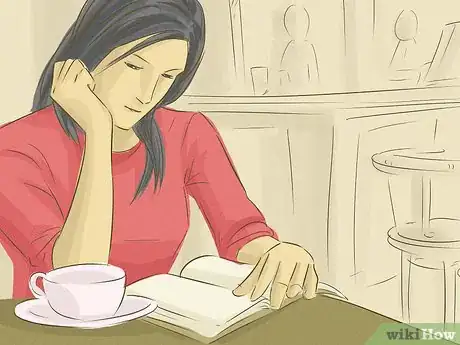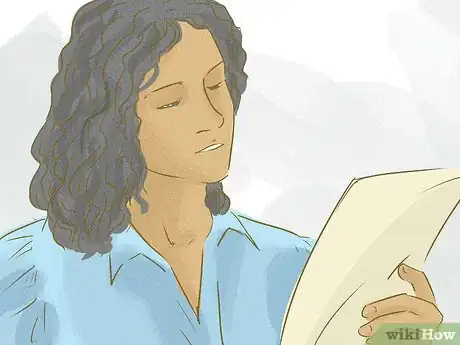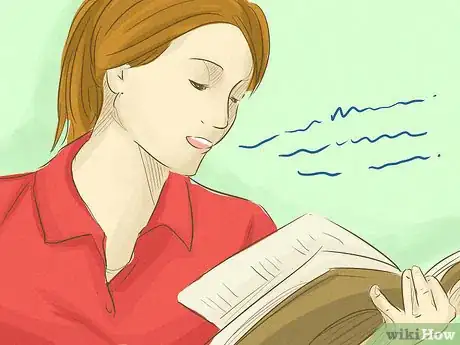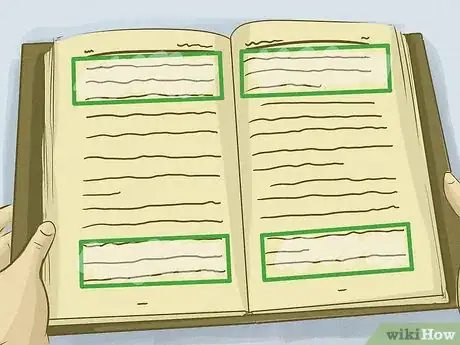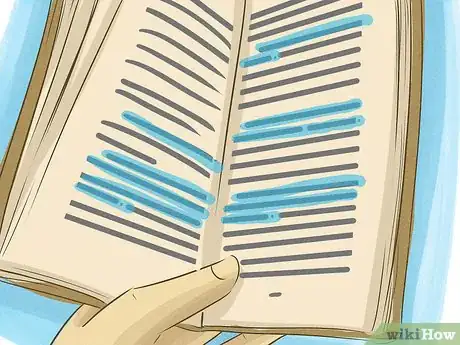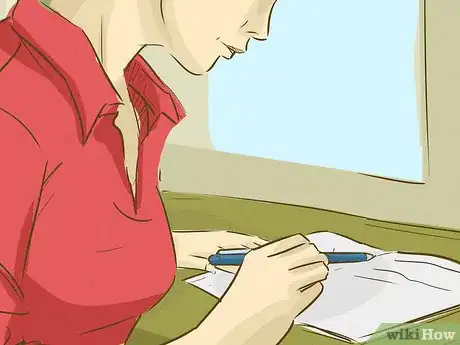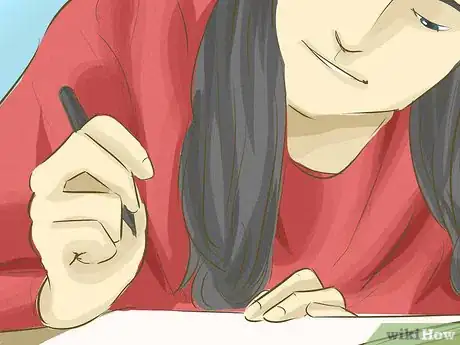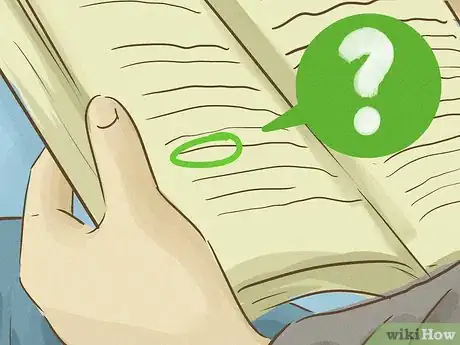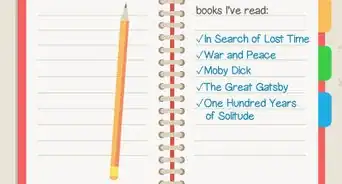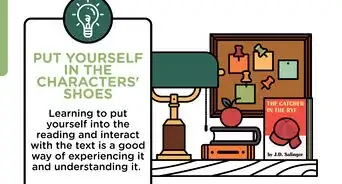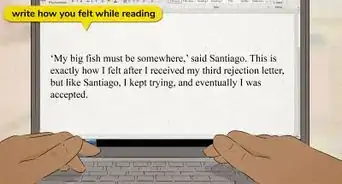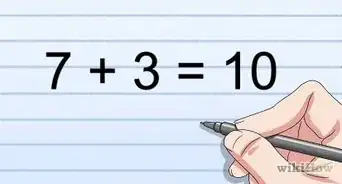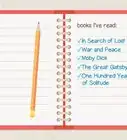This article was co-authored by Stephanie Wong Ken, MFA. Stephanie Wong Ken is a writer based in Canada. Stephanie's writing has appeared in Joyland, Catapult, Pithead Chapel, Cosmonaut's Avenue, and other publications. She holds an MFA in Fiction and Creative Writing from Portland State University.
wikiHow marks an article as reader-approved once it receives enough positive feedback. In this case, 85% of readers who voted found the article helpful, earning it our reader-approved status.
This article has been viewed 243,979 times.
With the constant distractions around you, it can be hard to absorb what you read in a meaningful way. You may struggle with absorbing a text for a class or reading a book for pleasure. To absorb what you read, start by creating a quiet reading environment. Then, make an effort to read the text slowly and carefully. You can also take notes on the text to help you absorb the content and better understand it.
Steps
Creating a Quiet Reading Environment
-
1Find a quiet, isolated area. Pick a reading spot that you know will be quiet and have the least amount of distractions. At home, this might be your bedroom or a room upstairs, away from shared areas like the kitchen or living room. At school, you may read in the quiet area of the library or in a quiet corner of the study hall.[1]
- Choose an area that has thick walls and a door or a partition. This will help to block out noise and other sounds that could distract you from your reading.
-
2Block out noise and distractions. If you know there is going to be noise where you are reading, wear noise cancelling headphones or ear plugs. Close all doors to keep out noise. This will help you stay focused on the text.
- You should also turn off your cellphone and your wifi. This way, you are not distracted by social media or text messages.
Advertisement -
3Tell others to leave you alone. Let those around you know that you are trying to focus on reading. Put up a Do Not Disturb sign on your door. Ask others around you to stay away from your room or area so you can try to absorb the text in peace.
- You may instruct others to leave you alone for a set period of time, such as 30 minutes or 1 hour. This way, you are assured of some peace and quiet for a set period of time so you can focus on the text.
Reading Slowly and Carefully
-
1Read a printed text. Reading a text that is printed on a page, rather than on a computer, will make it easier for your eyes to focus on the text. Print out texts that are online or on a computer so you have the physical copy. This way, your eyes will not have to strain to read the text on a computer, tablet, or phone screen. [2]
- If you are worried about using too much paper, print on both sides of the paper. Choose the double sided option when you print the text. You can also use recycled paper to print the text.
- Alternatively, you can read the text on an eReader or on a screen designed for reading small print. Make the text large and easy to read on an eReader so you do not have to strain your eyes when reading.
- If you are reading on a screen, turn the brightness down as low as possible while still being able to clearly see the text.
-
2Skim the text for keywords, ideas, and themes. Look for words that are repeated several times. Identify ideas that seem important to the rest of the text. Notice themes that reappear from page to page. Skimming the text for these elements will make it easier for you to then understand the rest of the text when you read it in full.[3]
- Keep these keywords, ideas, and themes in mind when you read the text in detail. Use them as a guide for your reading.
-
3Read the text out loud. Reading the text aloud to yourself can help you slow down and read the text more carefully. Listen to each sentence as you read it aloud. Pay attention to how the words sound on the page. Notice repetition, turns of phrase, and the language used in the text.[4]
- To keep the reading engaging, you may try reading the text aloud with a peer or friend. Take turns reading the text aloud. This will allow you to listen to the text when it is being read by someone else.
-
4Revisit passages you do not understand. If you struggle with certain sentences or sections in the text, re-read them. Read each word slowly and consider the meaning of each sentence in the section. Spend some time pulling apart the passage. This will help you better understand it. You can also try taking down notes on a paper about what you find important and what is difficult for you, for completely absorbing something try to understand everything don't leave anything (passage, word, concept, etc.) for later. [5]
- Once you have re read the passage from the same book or from your notes, consider it within the context of the rest of the text. Ask yourself, “How does this passage relate to the text as a whole?” “What does this passage say about the key themes or ideas in the text?” or test yourself.
Taking Notes on the Text
-
1Highlight or underline sentences you find interesting. Use a highlighter or a pen to underline important information. Look for sentences you find striking or interesting. Do not be afraid to markup the text with underlines and highlights, as this will force you to read the text more closely.[6]
- Try to only highlight or underline sentences that you think are really important. Highlighting or underlining the text too much can make it hard for you to identify sentences that are important, and you’ll end up with pages of underlines and highlights.
- Only highlight or underline the book if you own it and it is okay to do so. Library books, borrowed texts, and old texts may not be suitable for highlighting and underlining.
-
2Put notes in the margins. Reflect on the text as you read by jotting down notes in the margins. Write down short thoughts you have about the text. Put a question mark next to sentences you do not understand. Put one to two words next to lines that spark a thought for you.[7]
- For example, you may write in the margins “key detail” or “explores main theme.”
- Only make notes in the margins if you own the book and you are allowed to do so. Do not write directly in library books and old texts that are not yours.
-
3Make notes in a notebook if you can't mark up the book. You can also make notes about the text in a notebook or on a piece of paper. Pull quotes from the text that you find interesting or important and write them down in the notebook. Then, add notes next to it. Or put the page number from the text down next to the note.
- For example, you may make a note about a particular passage like, “important discussion of title” or “key character moment.”
- You may designate a notebook to a particular text so you can return to it for reference later. Having separate notes in a notebook may be a good idea even if you can write in the book.
-
4Create a list of questions about the text. Asking questions about the text will help you become a better reader. Pretend you are having a conversation with the text directly. Ask questions about passages you are confused about or intrigued by. Add to the list of questions as you read.[8]
- For example, you may ask questions like, “How does this sentence explore key themes in the text?” “Why did the author include this example?” “How does this passage make me feel as a reader?”
- Keep the list of questions in a separate notebook so you can refer to them later.
-
5Make a list of words you do not recognize. Identify any vocabulary that you are not familiar with or do not know the meaning of. Keep a running list of terms. Use a dictionary to look them up and then consider the definition in the context of the sentence. This will help you better understand the text and read it more closely.[9]
- You may keep a dictionary handy while you read the text so you can look up words quickly and easily.
- Keep the list of vocabulary in a separate notebook so you can look at them later. Most important is focus on your first read
Community Q&A
-
QuestionWhat should I take if I can't go to sleep at night when reading?
 Community AnswerAvoid bright light before sleeping. Also, try not to be on your phone or any electronic devices an hour prior to sleeping - the brightness and blue hues affect your brain. Read with soft lamplight and try to use an actual physical book. If reading in general is very stimulating for you and makes it hard to go to sleep, then just don't read that close to bedtime. Check out How to Fall Asleep if you need more help.
Community AnswerAvoid bright light before sleeping. Also, try not to be on your phone or any electronic devices an hour prior to sleeping - the brightness and blue hues affect your brain. Read with soft lamplight and try to use an actual physical book. If reading in general is very stimulating for you and makes it hard to go to sleep, then just don't read that close to bedtime. Check out How to Fall Asleep if you need more help. -
QuestionHow can I focus if I'm easily distracted?
 Community AnswerIsolate yourself from any possible distractions, such as your phone, computer, or video game systems. Leave those things in one room while you study alone in another. Also, don't hesitate to take breaks every 45 minutes to an hour. You will find that a break refreshes your mind and ultimately helps you concentrate better over time.
Community AnswerIsolate yourself from any possible distractions, such as your phone, computer, or video game systems. Leave those things in one room while you study alone in another. Also, don't hesitate to take breaks every 45 minutes to an hour. You will find that a break refreshes your mind and ultimately helps you concentrate better over time. -
QuestionWhatever I read I usually forget in only 10-20 minutes. What do I do?
 Community AnswerFollow the steps in the article along with repetition.
Community AnswerFollow the steps in the article along with repetition.
References
- ↑ https://sharpbrains.com/blog/2009/05/14/8-tips-to-remember-what-you-read/
- ↑ http://www.businessinsider.com/how-to-remember-everything-you-read-2015-9
- ↑ https://sharpbrains.com/blog/2009/05/14/8-tips-to-remember-what-you-read/
- ↑ http://www.businessinsider.com/how-to-remember-everything-you-read-2015-9
- ↑ http://www.businessinsider.com/how-to-remember-everything-you-read-2015-9
- ↑ http://www.lifehack.org/articles/productivity/the-secrets-reading-faster-and-absorbing-information-better.html
- ↑ http://www.businessinsider.com/how-to-remember-everything-you-read-2015-9
- ↑ http://www.lifehack.org/articles/productivity/the-secrets-reading-faster-and-absorbing-information-better.html
- ↑ http://www.businessinsider.com/how-to-remember-everything-you-read-2015-9
